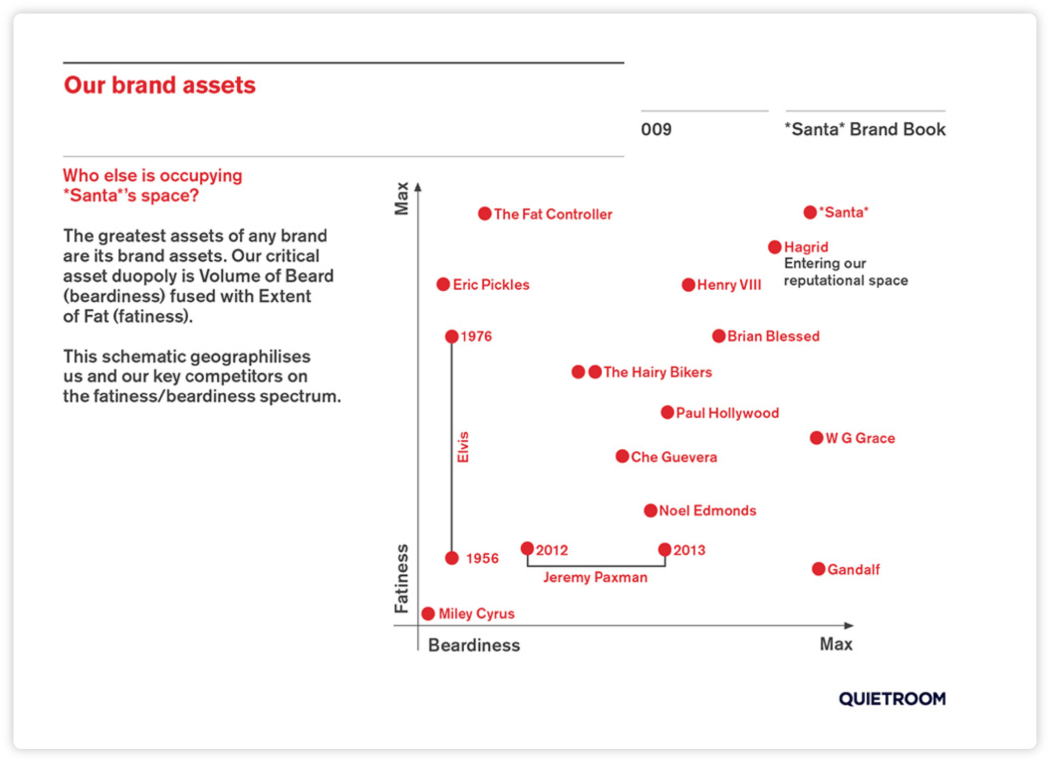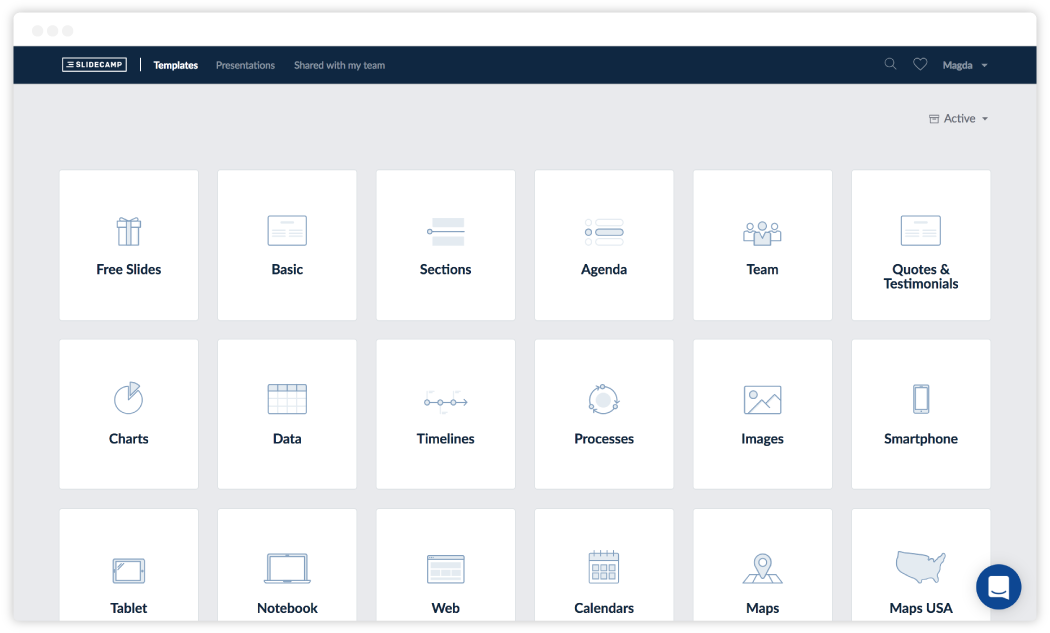Your company can spend months conducting market research, quizzing customers, and weighing up the competition to create the perfect brand identity book.
You can focus down on how best to document your image in design with fonts, palettes, and layouts carrying your message through to every advertisement, newsletter, and blog update. But there is one medium in which your brand book just seems to dissolve from a brand-spanking beautiful example of design, to a dusty old copy of Shakespeare…
And that medium is Presentations.
Presentations are the area in which designers, branding execs, and managers alike all struggle to keep messages on point. Whether that is in an internal financial update meeting, or in a sales presentation, employees think that embellishing their presentations will make them stand out. Which they do, but just not in the way they’re expecting.
So the mystifying question to many of us remains – how can we get our employees to keep to brand identity guidelines , and still feel they’ve added something creative?
How can we get our employees to keep on brand, and still feel like they’ve added something creative? Click To TweetBad Branding Consistency – Who’s to Blame?
Branding can be tricky in presentations
Keeping corporate branding consistent is difficult enough as it is. Regardless if you have 10 brands under your wing, or just the one, there is only so much a branding team can do to create the right image and express the right message to get your company to the top of its game. Learning how to educate and communicate well with all employees in every department will be the biggest step you can make towards making a branding book worthwhile.
You might have thought at some point that surely it’s the job of the communications department, or design team to keep people aware of the importance of brand consistency, and check their presentations are appropriate. But very often these are the departments far away from the day to day operations of customer service and sales, and sadly they’re probably lacking in mind-reading skills. So instead, it is these departments who suffer the most. Emails asking if they should use the full logo or just the logomark in the twitter profile picture (even though they’re clearly stated in the branding book) and the like, will meddle in their day to day tasks. Leaving those who are actually working on presentations not able to finish the work they’ve started until they’ve been sent a reply. This is time lost. Time which could be better spent with a simpler strategy which makes the most out of branding guidelines.
Make your Branding Books Employee Focused
There are so many factors which go into making a corporate branding strategy that it can be difficult for us as brief readers of branding guides to truly understand the depth meant by such a guide. But by incorporating humor into your style guide, your employees are much more likely to feel positive towards the branding guidelines, and also be able to recall certain elements for future use. This can seem a little difficult to implement. But luckily there’s a branding guide out there, created by the good people at Quietroom which can help us to see the key elements of creating a well thought out style guide, and how to make it just funny enough to be memorable for employees!

Created by a team of writers, trainers and strategists, who make content more meaningful to more people.
Ok, so corporate branding for Santa probably isn’t all that relatable to your product. But start thinking about it form the point of view of the elves, would they forget how to market Santa after reading this kind of material? We think neigh. The chances of buying any Hagrid themed toys for the kiddies next year would be quite a bit lower, and the jolly theme would likely be carried through to the projects throughout the year.
Essentially, add in some humor to your style guide (or at least something memorable) because keeping your employees interested in good branding standards is hard. But adding a little jollyness can replace hours of future formal follow ups.
Keeping your Employees Engaged with Branded Presentations
The answer to keeping your employees feeling engaged with the company message is definitely a multiple choice one. Depending on what product or service you provide, your best option will be a slightly different combination of the elements listed below.
Organization
Keeping everything organized is the absolute foundation of keeping brand guidelines easy for employees to follow. But organization sometimes can be a fluid concept, so ask yourself these questions and see what it is you’re missing:
- Where are all your presentations kept?
- Where are your current best presentation examples?
- When were your presentations last updated?
- Where are your companies differently sized logos kept?
- Where are your key policy presentation slides kept? E.g. Sustainability, Company Policies, Values.
- Where are all of the pre-approved photos kept, are they easily searchable?
- Is there somewhere for charts and pre-approved company data sources to be found by everyone?
- Is there a process for employees to upload their presentations for approval?
Chances are, that your answers will be a combination of email, dropbox, and other cloud platforms, but with no organizational structure between where you keep what. More of a ‘search some keywords in each’, and hope something pops up.
Organization can be improved by working out a strategy that works for your team. Some companies like to have different locations for different forms of information, so cross contamination is greatly limited. For example, if your team use Google Slides for PowerPoint presentations, it makes sense to keep those in a Google drive folder. If your team often use photos and videos, try designating these to live in your shared Dropbox folder. The same goes for other mediums. Word documents, Excel files, and scans should have a clear place in which they belong, and which is clear for all your employees.
Best Presentation Examples
A set of corporate identity guidelines will usually also be accompanied by presentation examples, or at least links to them. Chances are, that your company has a few pitch decks, or presentation templates floating their way around different departments. But ask yourself – are they actually easy to use? Or do they bore everyone silly. Think about having the best presentation examples available somewhere for people to feel inspired by, and to work towards. By setting up something which will be seen as a great example, you’re much more likely not to have employees wanting to stand out go off on their own creative journey towards branding inconsistency.
Rules
Procedures can also be encouraged. For example, the requirement of approval from design as well as designated people from certain departments. Unfortunately, many employees don’t dare to give presentation advice to team members without branding approval, for fear of having to take the blame if something is misinterpreted. By setting up an approved route of procedure (for example, asking for content advice first, then sending it to branding), you can solve the non-compliance problem of some employees. In addition to avoiding presentations with incorrect or out of date information.
Some businesses opt for having branding police in each department. This process involves investing a lot of time in one individual from each department, then sending them back to their own departments as the human knowledgebase of branding. For some companies this works very well. Usually as this individual has volunteered, and is interested in the brand identity and in branding consistency. These individuals can learn a lot from the questions they’re asked by their own team members, and find that promotions come more naturally as they increase their knowledge about the company and the specifics.
However, there are some problems that come with this option. Holidays, parenting responsibilities, and what to do if the individual decides to leave can cause problems with organization. But from company to company there will be a different solution, whether that’s training more than one person per department, or having a mentoring scheme.
DAM
DAM, your digital assets are fine. Or in other words, your files are quite in order.
But what is DAM? It’s an acronym for digital asset management, a piece of software which enables businesses to upload, keep up-to-date, and control permissions of files. Businesses can use DAM to store a library of their presentations, organize their approved photos, or just keep a digital newsletter up-to-date.
Take a look at what digital asset management actually is in this white paper from Nuxeo, and see how DAM can lead companies like EA to improve their company branding and communication on all fronts.
Education
Keeping employees up-to-date and motivated to stick to branding can be tricky. But by providing branding training and workshops you can fight misinformation and keep branding nice and easy for them. Remember that educating your employees should be just as much work as coming up with the ideas in the first place. Don’t let that get you down though, as much of that work can be delegated to department heads, external agencies or creative teams.
Some businesses feel that keeping your employees on track takes time, effort and often a lost afternoon while the whole office gathers to watch a PowerPoint. This can get in the way of productivity, and has to be done on a regular basis. However, there are other ways which you can encourage education of brand consistency in a non-time consuming, and continuous way. All the while accounting for new onboarding, employees who are off sick, and those you feel just might need a little re-education because it didn’t quite go in the first time.
A great route to go down is exploring an online SaaS product which can give short tutorials and quizzes to your teams. By allowing each individual to practice and be reviewed on their understanding of branding you can make sure everyone is literally on the same page.
One company offering just such a tool is Lessonly, who enable companies to create super simple, well designed online educational tutorials for their teams. On this platform you can keep the education of your employees up-to-date and on track with educational resources during all periods of their career progression. From the very first ‘Welcome to the Company!’ email to the ‘Christmas Dinner!’ invite, Lessonly encourage keeping entire teams educated and on the same page at all stage of their careers to avoid problems in the future.
Explain to your Team why Branding is Important

Convincing everyone that branding is important can be difficult
Employees, with the best of intentions can often change the message of the company without even realizing. We all know a few instances where a rogue customer service rep has tarnished the image of a company with just one badly judged reply. So what makes us believe this will be any different with our own brands? If there is something missing from the way your employees think your company should behave, then you need to re-address that, and correct it before it’s too late even for damage control.
This can also be a problem in presentations. Creative employees can also be likely to go ahead and find the images they like from sources which haven’t been approved, thinking that no-one watching the presentation will be likely to file a copyright complaint against them. Sadly, this is where the most drama stems from, innocent acts. Whether it’s a legal case, or just being far off the tone of the company, you should hammer home the message that only approved visuals should be used. Your team may spend a little while requesting approved images, but a future of only staying in the clear, away from legal disputes and off brand messages is definitely worth it for every company.
Discourage ‘creative’ Presentations
Employees are normal people. So they will from time to time, want to stand out in a big way. Maybe they know a new position is opening up, or it’s the time for salary reviews. Whatever the situation, people will see presentations as a chance to grab their superiors full attention, and have their chance to show how well they can present, and just how valuable they are. Many people say that their employees believe that ‘The magic happens in the middle’ of PowerPoint presentations. It doesn’t. Just having the company logo and color is not enough to present a company branded presentation. Tone, focus, and the language used should also be a main focus of any presentation to keep the branding consistent.
Encourage your employees to realize that the true meaning of a valuable team player is someone who understands the brand well, and proves to be consistent. That is the best value the company could wish for.
Ensure that those employees who present well within the lines of the company branding are rewarded, and their presentations are uploaded to your presentation space as a best practice example. By doing this, you will be enabling your entire workforce to understand how to shine, just don’t forget to also explain the reasons behind it!
Slide Libraries for Presentations
Giving your employees the right education is important, but equally so is keeping it easy. Regardless of how beautifully put together your branding book is, it won’t even be touched when a last minute presentation pops up. Instead, place your PowerPoint presentations, individual slides, and best in class examples on one clear platform. Making it easier for your employees to build their own business PowerPoint presentation from tailor made structures instead of using any sort of creative license.
We’re now going to finally make that anticipated namedrop: SlideCamp is just that platform. It’s an online place where everything to do with presentations in your company is kept. Whether it’s the finance department needing a graph, or PR needing a slide for a quote, they will be able to quickly find all the presentation slides they need, perfectly branded, and available 24/7.
Employees that find it difficult to be brief can also benefit from downloading entire presentation outlines with some of the content already filled in for commonly made presentations. For example, for sales figures. Instead of building up a presentation every time, outlines can be uploaded with the title, agenda, charts and graphs already formatted. Leaving the employee to simply change the data in the pre-linked excel sheet, and present in minutes.
Getting branding to be consistent in presentations can be a difficult thing to get all of your employees to value, but by taking in some small organizational changes, you can boost your company productivity levels, save time, and get even better professional in-house presentations made, 100% of the time.
Basically
Keeping branding consistent in presentations is hard because people all try to embellish their presentations and stand out.
This problem is faced by pretty much all managers and those responsible for keeping a company message clear and focused.
Branding style guides and rules need to be memorable for people, and need to be easily accessible. Try to make it harder to go against the brand, than to go with it.
Having employees as brand ambassadors is great.
Not only will your employees understand what your brand is about, but they will also be able to keep the message on point through their social media, word of mouth and how they communicate in their presentations.






